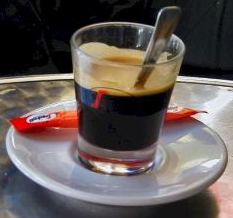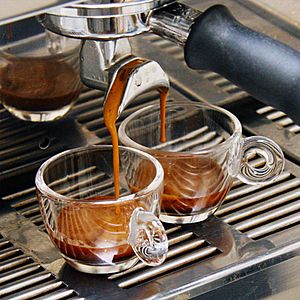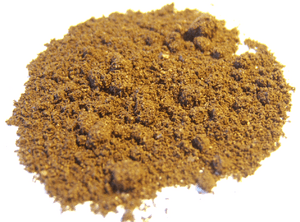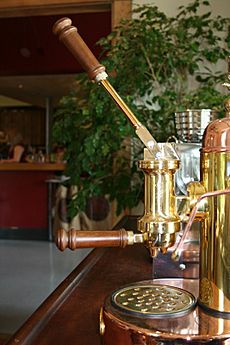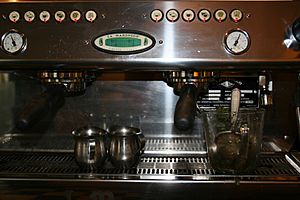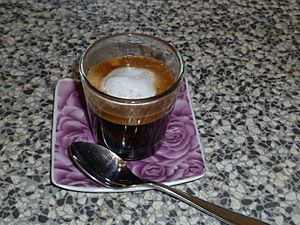Espresso facts for kids
Espresso is a strong, concentrated type of coffee from Italy. To make it, finely ground coffee beans are mixed with very hot water under high pressure. This happens inside a special machine called an espresso machine. Usually, about 7 grams of coffee beans are used for one shot. This gives espresso its very strong flavor. Because it's so strong, espresso is often mixed with milk or water to make other popular coffee drinks.
Contents
How Espresso is Made
Espresso is made by pushing very hot water through finely ground coffee. The coffee is pressed down firmly, which helps the water go through evenly. This process creates a thick, almost syrupy drink.
The foamy, reddish-brown layer on top of an espresso is called the crema. It forms when oils from the coffee mix with the water. This special foam doesn't happen with other ways of making coffee.
There isn't one exact rule for making espresso. But generally, an espresso machine is used. Making a shot of espresso is often called "pulling a shot." This name comes from old machines where you had to pull a handle. That handle would push hot water through the coffee. Today, most machines use an electric pump for the pressure.
Espresso Coffee Beans
Espresso is both a type of coffee drink and a way to make coffee. It's not a specific kind of coffee bean or a special way of roasting beans. You can use any type of coffee bean or roast level to make espresso.
For example, in southern Italy, people often like a darker roasted coffee for espresso. In northern Italy, they might prefer slightly lighter roasts. Outside of Italy, many different roasts are popular.
The History of Espresso
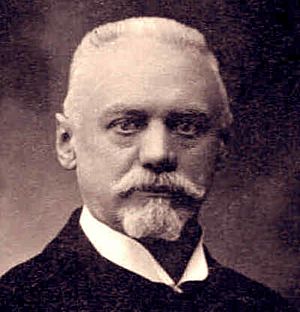
The first important step in making espresso machines happened in Turin, Italy, in 1884. A man named Angelo Moriondo received a patent for a machine that used steam to make coffee quickly. This machine could make coffee in large amounts, but not for one person at a time.
Seventeen years later, in 1901, Luigi Bezzera from Milan made some big improvements. He patented his ideas for a machine that could make and serve coffee right away. In 1905, Desiderio Pavoni bought this patent. He started the La Pavoni company and began making these machines in a small workshop.
Espresso became popular in different ways. In Italy, more people started drinking espresso as cities grew. Espresso bars became places where people could meet and socialize. Coffee prices were also lower if you drank your coffee standing up at the bar. This helped the "stand at a bar" culture grow.
In English-speaking countries, espresso became popular, especially as cappuccino. People liked drinking coffee with milk and the fun foam on top. In the United States, lattes became very popular. Some say the latte was invented in the 1950s in Berkeley, California. It then became famous thanks to Starbucks in the 1980s and 1990s.
In the United Kingdom, young people in the 1950s liked espresso. Coffee shops felt more welcoming than traditional pubs. At first, Italian espresso bars were simple places for Italian immigrants. But as special coffee shops grew in the 1980s, espresso became seen as a more fancy drink.
Today, people often talk about "Second Wave Coffee" for big coffee chains. "Third Wave Coffee" refers to more special, high-quality coffee shops. Espresso is also becoming more popular in the Middle East as Western coffee shops open there.
Espresso at Cafes vs. Home
More and more people are making espresso at home. You can find many different home espresso machines in stores and online. The first home espresso machine was the Gaggia Gilda. Other similar machines followed.
At first, home espresso machines were not very common. But then smaller electric pump machines came out. In recent years, it's become even easier to make espresso at home. This is thanks to automatic machines and systems that use coffee pods. Many coffee lovers now enjoy both home roasting coffee and making their own espresso.
Espresso Shot Types
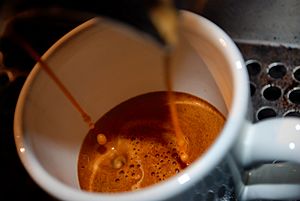
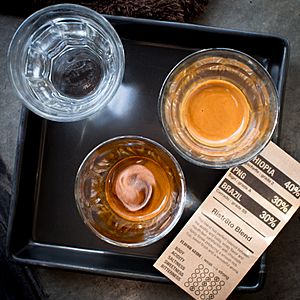
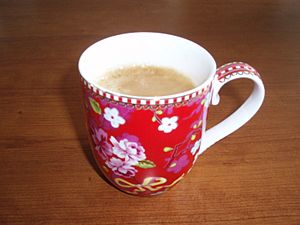
The main things that change an espresso shot are its "size" and "length." These terms are standard, but the exact amounts can be different.
Coffee shops usually have a standard shot size and length. They might offer a "triple ristretto" for example. They usually don't change how the coffee is ground for each order. Changing the grind takes time, and busy cafes need to make coffee quickly.
Shot Size
Espresso shots can be single, double, or triple. They use about 7, 14, or 21 grams of ground coffee. Special filter baskets are used for each size. The Italian word doppio is often used for a double shot. Solo (single) and triplo (triple) are used less often.
A single shot was the traditional size because it was the most a lever machine could easily make. True single shots are rare now. A "single shot" in a cafe is usually half of a double shot.
In drinks with milk, like lattes, a drink with three or four shots is called a "triple" or "quad."
Shot Length
The length of an espresso shot can be ristretto (short), normale (normal), or lungo (long). These names refer to how much liquid is in the shot. The amount of foam (crema) can make it hard to compare by volume.
- A ristretto is usually half the volume of a normale.
- A lungo is usually two to three times the volume of a normale.
For a double shot (using 14 grams of coffee), a normale uses about 60 ml of water. A double ristretto, which is popular in special coffee shops, uses about 30 ml of water.
To make a ristretto or lungo, the coffee is ground differently. It's ground finer for a ristretto and coarser for a lungo. This helps get the right amount of liquid by the time the brewing finishes.
A much longer shot is called a caffè crema. It's even longer than a lungo, usually 120–240 ml. It's made with a coarser grind of coffee.
Adding hot water to espresso makes it milder. But pushing too much water through the coffee grounds can add flavors that some people don't like.
Cold Espresso
Cold espresso (espresso freddo) is a different way to enjoy espresso. It's mostly served in southern Europe. It became popular in Greece in the early 1990s, along with cappuccino freddo.
To make a freddo espresso, two shots of espresso are brewed. Then, the coffee is stirred with sugar (if needed) and ice cubes in a special metal shaker until it's very cold. Finally, this cold coffee is poured into a glass full of ice cubes.
Drinks Made with Espresso
Espresso is often served on its own. But it's also mixed with other things, especially milk or hot water. Milk can be steamed, lightly foamed (microfoam), or very foamy.
Popular milk-based espresso drinks, from smallest to largest, include:
Other milk and espresso drinks are latte macchiato, cortado, and galão. These are mostly made with steamed milk and not much foam.
Espresso and water drinks include Americano and long black. Another mix is coffee with espresso, sometimes called a "red eye."
Here's how some common drinks are made:
| mixed with | |||
|---|---|---|---|
| frothed milk | hot water | ||
| espresso is on | top | latte macchiato | long black |
| bottom | caffè latte | caffè americano | |
How these drinks are made can be different depending on the drink and the person making it. For macchiatos, cappuccinos, flat whites, and smaller lattes or Americanos, the espresso is brewed right into the cup. Then, the milk or water is poured in.
For bigger drinks, where the cup won't fit under the machine, the espresso is brewed into a small cup first. Then, it's poured into the larger cup. This is how a latte macchiato or a classic red eye is made. For a long black, the espresso is brewed directly into a cup that already has hot water. This helps keep the foamy crema on top.
Related pages
Images for kids
See also
 In Spanish: Café expreso para niños
In Spanish: Café expreso para niños


